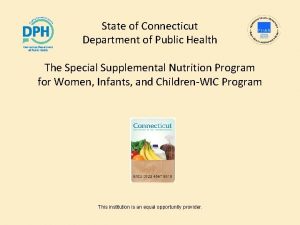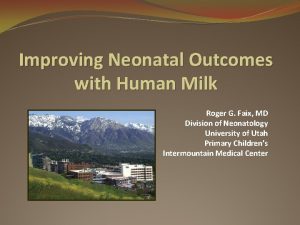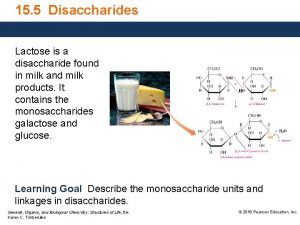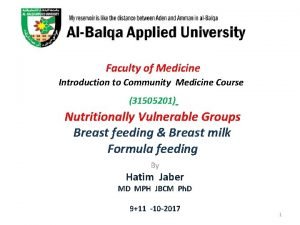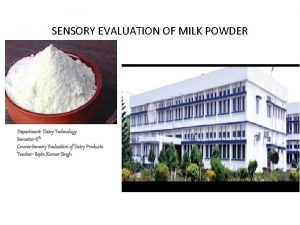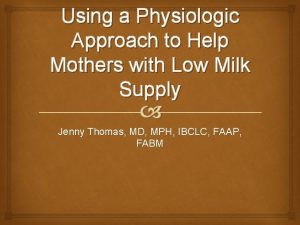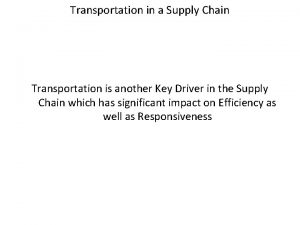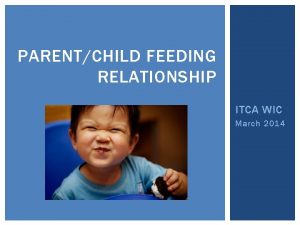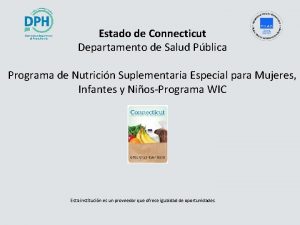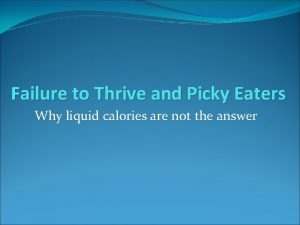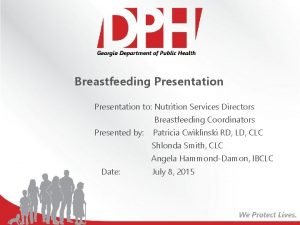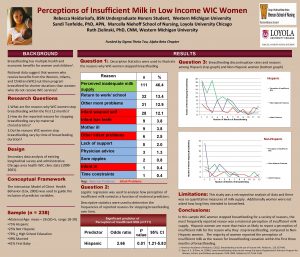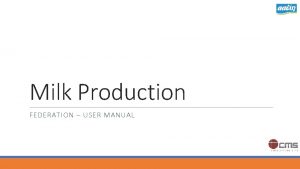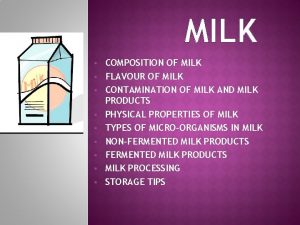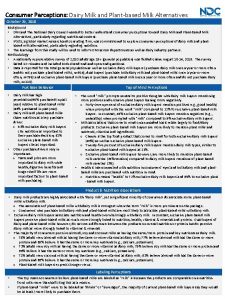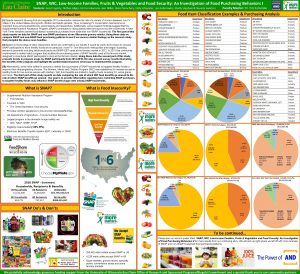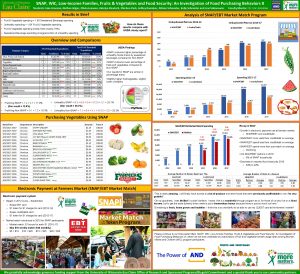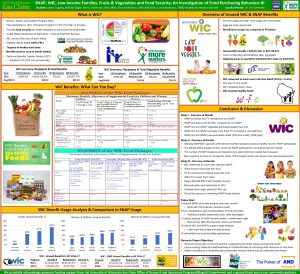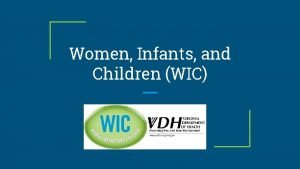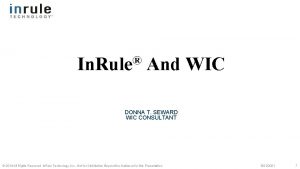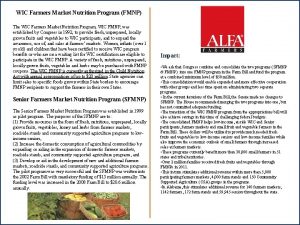Perceptions of Insufficient Milk Supply in LowIncome WIC































- Slides: 31

Perceptions of Insufficient Milk Supply in Low-Income WIC Women Rebecca Heidarisafa BSN Undergraduate Honors Student Western Michigan University Honors Committee Ruth Zielinski Ph. D, CNM – Chair Wendy Kershner M. S. N. , C. P. N. P. , IBCLC Sandi Tenfelde, Ph. D, APN Marcella Niehoff School of Nursing, Loyola University

Objectives Background and Significance o The problem o Study design o Results o Implications for nursing practice o

Background and Significance o o o Breast milk is the optimal nutrition for infants (AAP, 2012) Benefits to infant Decreased rates of obesity, infection, asthma, allergies n o Increased neurodevelopment Benefits to mother n n Decreased risk of post partum hemorrhage, breast and ovarian cancer Increased self esteem (Labbok, 2001)

Expert recommendations o o o World Health Organization, Healthy People 2020, American Academy of Pediatrics Exclusive breastfeeding for at least 6 months Duration of at least a year (APP, 2012; WHO, 2012; U. S. Department of Health and Human services, 2012)

How are we doing? o o Consistently the recommendations are not being met (U. S. Department of Health and Human services, 2012) Worse among low income women who receive benefits from the Women, Infants & Children (WIC) program (Ryan & Zhou, 2006)

Healthy People 2020 Goals 2020 Goal Initiation 81. 9% Low-Income Women NO WIC Low-Income Women WIC Exclusivity at Duration at 6 months 3 months 60. 6% 46. 2% Duration at 12 months 34. 1% 86% 24% 56% 26% 63% 10% 26% 12%

What is WIC? o o Enacted in 1974 by the Federal government A supplemental nutrition program for women, infants, and children Provides food items to low income families, including formula WIC supports breastfeeding

Why do women discontinue breastfeeding? o o Perception of insufficient milk (PIM)A mother’s actual or perceived lack of breast milk (Hill & Humenick, 1989) Most common reason for discontinuing (Arlotti, Cottrell, Lee, & Curtin, 1998; Pollard & Guill, 2009; O’Brien, Fallon, Brodribb, & Hegney, 2007; Ahluwalia, Morrow, & Hsia 2005; Bunik et al. , 2010; Amir & Cwikel, 2005; Lewallen et al. , 2006; Agrasada & Kylberg, 2009) o Introduce formula earlier (Hill & Aldag, 2007; Heinig et al. , 2006)

PIM Among Low Income Women o o o Understudied PIM a potential for low income women wanting to breastfeed exclusively (Heinig et al 2006) Low income women may be more at risk for PIM (Gatti, 2008)

Study purpose 1. 2. To explore the reasons for discontinuation of breastfeeding in a sample of low income women receiving WIC Explore the influence of maternal background and dynamic variables on the reason for discontinuation

Interaction Model of Client Health Behavior

Study Design o o o Analysis of existing data Chicago area WIC clinic Data from WIC tracking forms, nutrition and health surveys 4 year period (1999 -2003) n=1500 low income women

Study Design o o o Secondary analysis of Dr. Tenfelde’s dissertation data Predictors of Breastfeeding Exclusivity in a WIC Sample (Tenfelde, Finnegan & Hill, 2009) IRB Approval at WMU was obtained

Methods o o 309 women received WIC and initiated breastfeeding Women were excluded if: n n Less than 37 weeks Infant weighed less than 2500 gms Had health complications Were placed for adoption

Methods o o o Data was collected during pregnancy, at 2 -3 days, 1 month, 6 months and 12 months post partum 238 of the women both discontinued breastfeeding during the 12 months and gave a reason Women were instructed to select the main reason for discontinuing from a list

Analysis o o o SPSS Descriptive statistics Logistic regression n n o PIM as dependent variable Maternal characteristics as independent variables Data also analyzed by time of discontinuation

Background Variables (n = 238) o o o o Mean age 26 (18 -39 years) Mean income $11, 868($0 -$32, 568) 79% high school or less 38% married 75% Hispanic 70% planned return to work/school 74% knew someone who breastfed 57% had breastfeeding support

Background Variables (n = 238) o o o 41% primigravida 47% overweight/obese 44% previously breastfed 41% first-trimester prenatal care 86% vaginal births

Dynamic Variables (n = 238) o o 15% planned to exclusively breastfeed 49% wanted breastfeeding information 61% attended prenatal education 20% felt low or depressed after delivery

Results – Sample Description (n = 238)

Reasons women gave for discontinuation Key: Maternal Problems Infant Problems

Influence of background variables o o o Maternal education Breastfeeding support Ethnicity n Women who self reported Hispanic ethnicity were more likely to stop breastfeeding due to a perception of insufficient milk (OR 2. 66, p =. 01, 95% CI 1. 21 – 5. 83)

Breastfeeding discontinuation rates and reasons among Hispanic women Number of Women Stopping Breastfeeding 20 Hispanic 15 Perception of Insufficient Milk Other Maternal Problems 10 5 0 1 2 3 4 5 6 7 8 9 10 11 12 Number of Months of Breastfeeding Infant Problems

Number of Women Stopping Breastfeeding discontinuation rates and reasons among non- Hispanic women 14 12 10 8 6 4 2 0 Non. Hispanic Perception of Insufficient Milk 1 2 3 4 5 6 7 8 9 10 11 12 Number of Months of Breastfeeding Other Maternal Problems

Comparison of PIM rates over time for Hispanic/Non-Hispanic Women % of Women Stopping Breastfeeding due to PIM 120 100 80 60 Hispanic Non-Hispanic 40 20 0 1 2 3 4 5 6 7 8 9 10 11 12 Number of Months of Breastfeeding

Limitations o o Secondary analysis of data No actual measures of milk supply How long did women intend to breastfeed Women may have had multiple reasons for discontinuation

Conclusions o o Almost half the women stopped because of PIM Three month mark may be a significant time in women’s lives n n n o Introduction of solids? Growth spurt? Return to work? Hispanic women are more likely to discontinue due to PIM

Implications for Nursing o § § § o o Education Infant Cues Infant output Supply and Demand Understand reasons for discontinuation Further research is indicated

References Agrasada, G. , & Kylberg, E. (2009). When and why Filipino mothers of term low birth weight infants interrupted breastfeeding exclusively. Breastfeeding Review, 17(3), 510 Ahluwalia, I. , Morrow, B. , & Hsia, J. (2005). Why do women stop breastfeeding? Findings from the Pregnancy Risk Assessment and Monitoring System. Pediatrics, 116(6), 1408 -1412. American Academy of Pediatrics. (2012). Breastfeeding and the use of human milk. Pediatrics, 129, 827 -841. Amir, L. H. , & Cwikel, J. (2005) Why do women stop breastfeeding? A closer look at ‘not enough milk’ among israeli women in the negev region. Breastfeeding Review, 13 (3), 7 -7 -13. doi: 10. 2268/1818 -1822. 13. 3. 3617 Arlotti, J. , Cottrell, B. , Lee, S. , & Curtin, J. (1998). Breastfeeding among low-income women with and without peer support. Journal Of Community Health Nursing, 15(3), 163 -178. Bunik, M. , Shobe, P. , O’Connor, M. E. , Beaty, B. , Langendoerfer, S. , Crane, L. , & Kempe, A. (2010) Are 2 weeks of breastfeeding support insufficient to overcome formula? Academic Pediatrics, 10 (1), 21 -28. Cox, C. L. (2003) Online exclusive: A model of health beahvior to guide studies of childhood cancer survivors. Oncology Nursing Forum, 30, E 92 -E 99. Dewy, K, (2001) The challenges of promoting optimal infant growth Journal of Nutrition, 131(7), 1879 -1880. Gatti, L. (2008). Maternal perceptions of insufficient milk supply in breastfeeding. Journal of Nursing Scholarship, 40 (4), 353 -363. Hill, P. , & Aldag, J. (2005). Milk volume on day 4 and income predictive of lactation adequacy at 6 weeks of mothers of nonnursing preterm infants. Journal Of Perinatal & Neonatal Nursing, 19(3), 273 -282. Hill, P. , Aldag, J. , Zinaman, M. , & Chatterton, R. (2007). Predictors of preterm infant feeding methods and perceived insufficient milk supply at week 12 postpartum. Journal Of Human Lactation, 23(1), 32 -38. Hill, P. D. , & Humenick, S. S. (1989) Insufficient milk supply. Image: Journal of Nursing Scholarship, 21, 145 -148.

References Continued Lewallen, L. P. , Dick, M. J. , Flowers, J. , Powell, W. , Zickefoose, K. T. , Wall, Y. G. , & Price, Z. M. (2006 ). Breastfeeding support and early cessation. JOGNN: Journal of Obstetric, Gynecologic & neonatal nursing, 35 (2), 166 -172. O’Brien, M. , Fallon, A. , Brodribb, W. , & Hegney, D. (2007) Reasons for stopping breastfeeding: what are they, what characteristics relate to them, and are there underlying factors? Birth Issues, 15(3 -4), 105 -113. Pollard, D. , & Guill, M. (2009). The relationship between baseline self-efficacy and breastfeeding duration. Southern Online Journal Of Nursing Research, 9(4), Ryan, A. S. , & Zhou, W. (2006). Lower breastfeeding rates persist among the Special Supplemental Nutrition Program for Women, Infants, and Children participants, 1978– 2003. Pediatrics, 117, 1136– 1146. Tenfelde, S. , Finnegan, L. , Hill, P. (2011). Predictors of breastfeeding exclusivity in WIC sample. Journal of Obstetrics, Gynecological, & Neonatal Nursing, 40, 179 -189. U. S. Department of Health and Human Services. (2012). Healthy People 2020. Retrieved March 8, 2012 from http: //healthypeople. gov/2020/topicsobjectives 2020/objectiveslist. aspx? topic. Id=26 World Health Organization. (2012). Infant nutrition. Retrieved March 8, 2012 from : http: //www. who. int/topics/infant_nutrition/en/

Questions?
 Wic approved juice
Wic approved juice Yogurt whole milk wic
Yogurt whole milk wic Difference between cow's milk and breast milk
Difference between cow's milk and breast milk Milk for toddlers with milk allergynon dairy
Milk for toddlers with milk allergynon dairy Lactose disaccharide
Lactose disaccharide Human milk vs cow milk
Human milk vs cow milk Contamination of milk and milk products
Contamination of milk and milk products Sensory evaluation of dairy products
Sensory evaluation of dairy products Insufficient grades
Insufficient grades Illusion of irrevocability
Illusion of irrevocability Insufficient glandular tissue pictures
Insufficient glandular tissue pictures Insufficient cashflow
Insufficient cashflow Trustyourperceptions
Trustyourperceptions Psychedelic drugs that distort perceptions and evoke
Psychedelic drugs that distort perceptions and evoke Drugs that alter moods thoughts and sense perceptions
Drugs that alter moods thoughts and sense perceptions A chemical substance that alters perception and mood
A chemical substance that alters perception and mood Drugs that alter moods, thoughts, and sense perceptions
Drugs that alter moods, thoughts, and sense perceptions Intermediate transit point
Intermediate transit point Chapter 5 section 1 supply and the law of supply
Chapter 5 section 1 supply and the law of supply Ang elastisidad ng supply ay?
Ang elastisidad ng supply ay? Matching supply and demand in supply chain
Matching supply and demand in supply chain Itca wic
Itca wic Wic handelsroute
Wic handelsroute Tn wic food list 2021
Tn wic food list 2021 Pars.state.wic
Pars.state.wic Formulas aprobadas por wic
Formulas aprobadas por wic Wic yogurt
Wic yogurt Georgia wic procedures manual
Georgia wic procedures manual Wic bread
Wic bread Wic pcdb
Wic pcdb Nc wic formula
Nc wic formula Wic similac total comfort
Wic similac total comfort
